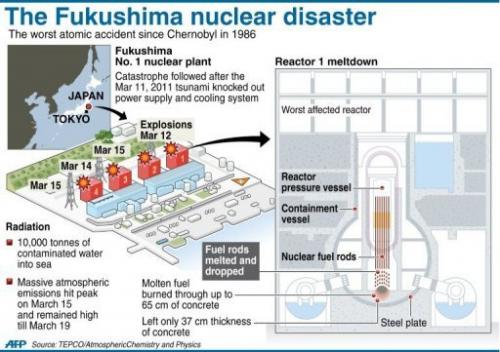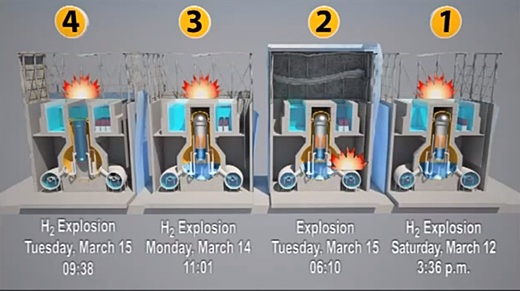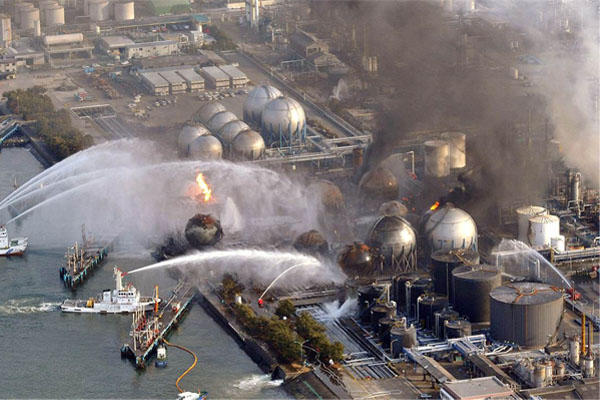On Friday March 11th, 2011 at 2:46 PM an exceptionally powerful earthquake hit the pacific coast of Honshu, the main island of Japan. At 3:36 PM less than an hour after the earthquake, a tsunami swept over the coast, the waves went all the way up to 10 km in land result over 20,000 people dead or missing, destroyed towns, ports, and lands devastated. Nuclear power plants were also affected, one in particular namely the Fukushima Daiichi.
Fukushima Daiichi is 250 km north east of Tokyo, the nuclear power plant has six reactors. Each reactor successively commissioned during the 1970s. Units one, two, and three were operating at full power. The core in unit four was unloaded, units five and six were in cold shutdown. Fukushima reactor’s have a different technology than the pressurized water reactors built by the French operator EDF, they are boiling water reactors called BWRs. They called reactor because the heat in the core is produced by fission reactions. Boiling water, because the water that removes the heat from the core turns into steam and the steam goes directly to the turbine, the turbine drives the generator that produces electricity, afterwords the steam is condensed with the help of a sea water cooling system and returns to the core. A boiling water reactor has only one single system combining feed water and steam. The core is composed of few assemblies containing uranium it is controlled by control rods introduced from the bottom that can stop the fission reactions in case of an emergency, fission of uranium nuclear produces radioactive atoms that intern produce heat and this continues to occur even after reactor shutdown, this is called “Residual Heat” keeping the fuel cool is a major safety issue.
The fuel is isolated from the environment by different containment barriers just like the famous Russian dolls. The first barrier the fuel cladding of zirconium alloy , a second barrier the steel reactor vessel in combination with steam and water cooling systems. Finally, the third barrier the containment building in concrete with the leak tight steel liner. The fuel is kept under water in the reactor as well as in the adjacent pool where the spent fuel is unloaded a the pool is located at the top of the reactor vessel to facilitate the transfer fuel underwater.
When the earth quick hit the coast seismic sensors trigger the insertion of control rods. although fission reaction stopped, the residual heat had to be removed. the offside power supply was lost in the emergency diesel generators took over automatically. They supply electricity to the backup systems needed for core cooling. In reactors two and three it is a turbo pump. the steam generated by the reactor operates the turbopump which feeds water into the reactor vessel the steam is condensed in the wet well suppression pool within the containment. In reactor one there was no turbo pump but a heat exchanger which condensed steam from the reactor vessel, the condensed water was reintroduced into the reactor vessel by gravity. This heat exchanger provided core cooling by natural convection for more than 10 hours until then everything seems under control. However reactor one due to excessive cooling force the operators to temporarily isolate the heat exchanger in compliance with operating procedures. the tsunami wave arrived less than an hour after the earthquake. The waves went over the seawall flooding over the lower parts of buildings and disable the emergency diesel generators, on reactor one the operator was unable to reactivate the heat exchanger, the core was no longer cool it would be the first to melt. On units two and three the batteries were still operational. They operated some of the valves the turbine driven palms ran for nearly 24 hours and then stopped.
The cores were no longer cooled. the meltdown scenario is almost the same at all three reactors only the dates change. The water in the reactor vessel evaporated the fuel became un covered heated up to a temperature of 2300°C, the fuel melted and mixed with the materials from the structured to form a magma called corium. the corium flowed down to the bottom of the reactor vessel. according to Japanese officials it pierced the reactor vessel before falling on the concrete base mat inside the containment.
At the same time still in the reactor vessel, the steam is loaded with radioactive elements and hydrogen. Heated at high-temperature the fuel cladding is oxidized and cracks releasing volatile radioactive elements. In addition to this, the zirconium of the fuel clad created a reaction with the steam by absorbing the oxygen and by releasing hydrogen. Normally, when mixed with air hydrogen catches fire and explodes. However the containment building was filled with nitrogen and an inert gas that avoids the presence of oxygen, at this stage there was no risk. as the steam pressure rose to a dangerous level in the reactor vessel the depressurizing valves opened, gas was forced into the wet well suppression pool by inventing line, the water acted as an efficient filter by trapping much of the radioactive elements. But the water was no longer cooled because the emergency diesel generators were out of order, and it’s soon began to boil thereby reducing it’s filtration capacity.
The wet well suppression pool in the communicating containment began to enter into an over pressure situation, to avoid containment rupture the operator decided to release the gas into the atmosphere. Normally the venting line should have led all the gas outside the building but hydrogen was escaping through uncontrolled leakage pathways it was released into the reactor building. Hydrogen reacts violently with oxygen in the air, the explosion part of the frame at the top of the building apparently without damaging the containment building. Radioactive elements not yet trapped in the wet well suppression pool were released into the environment. Due to the absence of usable freshwater on the side, the operators decided to inject seawater water into the reactor vessel, this solution far from ideal since salt is chemically active had at least the advantage of cooling and stabilizing the corium. In the four days following the tsunami the four reactors were damaged by explosions and three of them with core melt, although it has kept its structure intact, reactor two is the current source of the most important radioactive releases into the soil as well as into the sea. The explosion took place inside the building operators encountered difficulties depressurizing the containment in the wet well suppression pool broke. This loss of leak tightness led to the discharge into the atmosphere of unfiltered radioactive elements into the spreading of highly contaminated water in the buildings leading to highly polluting discharging into the sea.
The explosion of reactor four was due to hydrogen even though the core was completely unloaded the hydrogen came from reactor three via a joint pipe. The reactor storage pools were also a great concern because they had lost their cooling systems and in addition to this, they were not protected by any containment. Very little spent fuel was stored in pool one, however there was much more in pools two, three, and four. Especially pool four which contained the equivalent of the three cores. In all three pools the water started to boil and without the help in extremis of cold water from helicopters and from a firehose the spent fuel would’ve caused considerable radioactive release into the environment. Gradually, the situation began to stabilize by the end of March 2011, freshwater had replaced seawater. In July the reactor cooling system was again in operation in closed circuit, thereby avoiding discharges of contaminated water into the environment. In December 2011 Japanese authorities officially declared that the nuclear power plant reached the cold shutdown state, an expression used when the cooling water does not evaporate anymore and remains liquid below 100°C. This nuclear crisis was managed by men working under extremely difficult conditions, cut off from the rest of the world with no news from their families after the tsunami without any power supply threatened by radiation they fought with all their force to cool the reactors trying to make invade the backup systems work again or by using improvised means. After this race against time to cool the plant followed a year where about 20,000 workers succeeded each other trying to regain control of the plant by the following:
- Enhancing the dyke against another tsunami.
- Mapping the site contamination.
- Clearing every access to the site.
- Immobilizing radioactive dust.
- Treating and disposing of contaminated water.
- Avoiding further radioactive release.
In the years ahead the challenge will be to remove the spent fuels from the pools for final storage and radioactive waste repositories. Eventually on the long term under the critical eye of international experts the issue will give way to a challenge, namely to remove the melted fuel from the three damaged reactors and to dismantle the site. As we can see a huge task awaits the Japanese, a task that started in March 2011 and that will last for several decades
References:
http://www.world-nuclear.org/info/Safety-and-Security/Safety-of-Plants/Fukushima-Accident/
http://time.com/worlds-most-dangerous-room/
http://www.techtimes.com/articles/13316/20140818/fukushima-disaster-show-effects-of-radiation-in-animals-plants-study.htm
http://www.hiroshimasyndrome.com/fukushima-accident-updates.html




